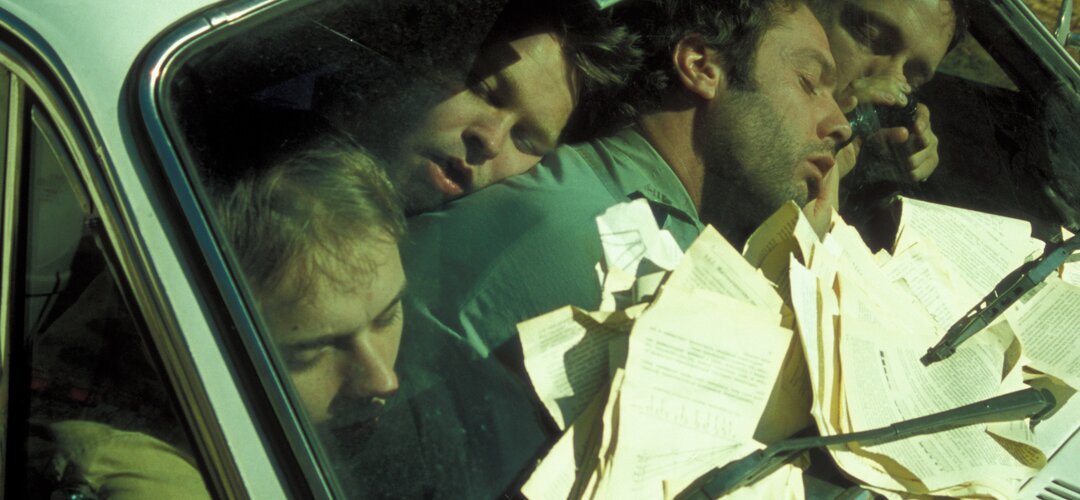This is probably how ideas catch fire - stupid people in a garage somewhere come up with an idea and then other people make it important.
JO STRØMGREN KOMPANI was officially founded in 1998 by Jo Strømgren and Agnes Kroepelien in Bergen, Norway. A not so luxurious office was rigged in Jo Strømgren’s former bedroom, later in his living room, and from there on advancing step by step up the ladder of corporate commodity. A classic and healthy start where all involved know how to appreciate every single improvement. Apart from fulfilling the myth of a young artist collective with charm and optimism, the company imposed a radically high working pace and adapted corporate efficiency standards. Full throttle forward – no compromise.
During the following years, Jo Strømgren Kompani rose to become one of Norway’s leading exporters of culture, criss-crossing the world on parallel tours with multiple productions, and playing an active part in domestic culture politics. In 2008, with 22 productions already on the repertory, the company celebrated their 10 year anniversary with 10 different shows on the road and completing a touring list that covered about 45 countries.
Extreme numbers, even for companies far more famous and resourceful than JSK. Some choose to call it a small miracle. But how did the company get here? Was the artistic talent of Jo Strømgren and his collaborators enough? Or was a master strategy just as important? In 1998 the company defined three hardcore ambitions:
The first ambition
was to develop a distinct and personal artistic style as far away from the current trends as possible. This in order to avoid swimming with all the rest in the ever so ephemeral mainstream hypes. A difficult and brave decision considering the fact that Norway was practically invisible on the international dance arena at that time. The risk of getting lost in the periphery was evident.
The second ambition
was to collaborate with institutional theatres. A well known production model internationally, but quite a task to pursue in Norway at that time. Mutual skepticism between the independent scene and the institutional theatres was an evident obstacle. The synergy of combined resources was yet to be tested and proved, and there were no lucid good examples for others to follow.
The third ambition was to establish international connections and build an international audience. Norway is a small country with radical seasonal weather changes, also in the cultural terrain. Dependence on unstable domestic funding and reliance on unpredictable popularity shifts in a small community seemed too much of a risk to take. A bigger market means greater safety. And cultural exchange is pointless if done only between local peers. Strangers need to meet and the best way is to go out and look for people unlike yourself.
Easy or difficult? Due to the time and place these ambitions were set, it implied that JSK in most cases would undergo the fate of a test pilot. The company has had their shares of crashes, but learning the hard way is also the best way to gain competence. The artistic trademark has taken a very clear form in terms of the extensive research on and use of nonsensical languages. A new niche has been opened, so to speak. Or reopened if one includes this technique as an ancient method of associative communication. Hopelessly untrendy as ever, but with no copy-cats or competitors in sight. This has given the company the freedom to develop its distinct style in peace. The collaborations with institutional theatres have achieved good results, allowing the company able to exploit resources from the big fish, yet still stay as independent as ever. The international impact is visible in more than one sense. Extreme geographical variation is one thing. Presence at prestigious festivals and venues is another. Yet more important is the close and personal relationships with artists and organisers worldwide that can provide not just dialogue, feedback, and inspiration, but also security in terms of co-productions and long term distribution intentions.
All in all, the history of JSK can be told in many ways and from many viewpoints. On a website one has to choose. Internal gossip, promotional praise, intellectual coverup, look-how-exotic-we-are-from-the-home-of-the-polarbears-lies. Whatever angle, it should have a purpose beyond public image masturbation. JSK finds its own story interesting by the decision to involve corporate business strategies with the artistic process. The radical development is a direct result, and the hope is that some readers of this site may become less fearsome of this way of thinking. For those categorically negative to such ideas, there is no point trying to judge JSK by its commercial philosophies – JSK still represents some of the strangest and potentially most incomprehensible things you can see on a stage. By normal predictions, JSK was not supposed to get a broad audience at all. But life in a cult is no life for JSK.
Yearly Reports (in Norwegian)
Årsrapport – Jo Strømgren Kompani 2020
Årsrapport – Jo Strømgren Kompani 2019
Årsrapport – Jo Strømgren Kompani 2018
Årsrapport – Jo Strømgren Kompani 2017
Årsrapport – Jo Strømgren Kompani 2016
Årsrapport – Jo Strømgren Kompani 2015
Årsrapport – Jo Strømgren Kompani 2014
Årsrapport – Jo Strømgren Kompani 2013
Årsrapport – Jo Strømgren Kompani 2012
Årsrapport – Jo Strømgren Kompani 2011
Årsrapport – Jo Strømgren Kompani 2010
